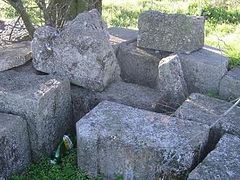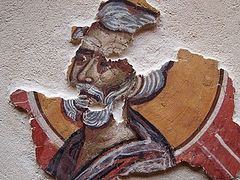Source: Archaeology in Bulgaria
April 7, 2016
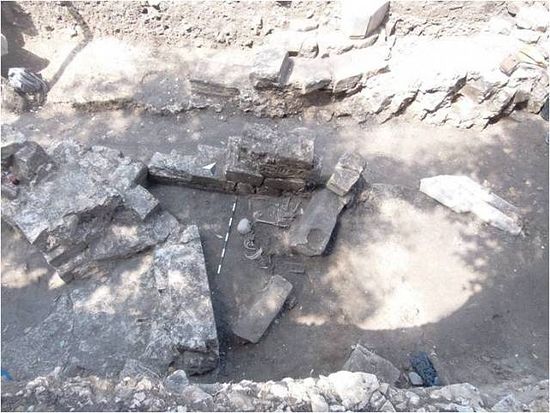 A 10th century church with a necropolis has been discovered by the Ruse archaeologists during their participation in the rescue digs in the nearby Danube city of Silistra, the modern-day heir to Durostorum (in the Antiquity) and Drastar (in the Middle Ages). Photo: Ruse Regional Museum of History
A 10th century church with a necropolis has been discovered by the Ruse archaeologists during their participation in the rescue digs in the nearby Danube city of Silistra, the modern-day heir to Durostorum (in the Antiquity) and Drastar (in the Middle Ages). Photo: Ruse Regional Museum of History
A church from the 10th century, dozens of medieval graves, and coins testifying to the Tatar (Mongol) invasion of the Second Bulgarian Empire (1185-1396 AD) in 1242 AD have been discovered during rescue excavations of the medieval city of Drastar, known as Durostorum in the Antiquity, in today’s Danube city of Silistra in Northeast Bulgaria.
These findings have just been presented to the public by archaeologists Nikola Rusev and Varbin Varbanov from the Ruse; the discoveries were made in the late summer and fall of 2015 when their team participated in the rescue excavations in the city of Silistra after a local water supply rehabilitation project exposed a number of archaeological structures from different time periods.
The rescue digs in Silistra, which was a major regional center in the Antiquity and Middle Ages, continued for several months as part of the rehabilitation of the city’s water supply and sewerage system. They also led to the discovery of the outer fortress wall of the Ancient Roman city of Durostorum (as the city was known in the Antiquity period).
As a result the local archaeologists from the Silistra Regional Museum of History and their colleagues from the nearby cities have excavated dozens of buildings from the time of the Roman Empire, the Byzantine Empire, and the First Bulgarian Empire (632/680-1018 AD).
The scope of the rescue excavations was too great, and archaeologists from other Bulgarian cities had to come to the aid of their colleagues from Silistra, researching various sections.
In their section, the Ruse archaeologists have unearthed archaeological layers and structures from three major historical periods in the High and Late Middle Ages – 10th-12th century, 13th-14th century, and 17th-19th century.
According to Rusev, their most impressive discovery from the rescue digs of medieval Drastar (known as Durostorum (Dorostorum) in the Antiquity and also known as Dorostol in the Middle Ages) has been the ruins of a medieval church dating back to the early 10th century, which existed at least until the 11th century.
“Its functioning was connected with the adoption of Christianity by the Bulgarian Tsardom," says the archaeologist, as cited by the Ruse Museum and local news site Ruse Info.
The First Bulgarian Empire formally adopted Christianity as a state religion in 865 AD from Byzantium, after a protracted battle between Rome and Constantinople over who would convert the Bulgarians. In 870 AD, the head of the Bulgarian Orthodox Church was granted the rank of Archbishop.
In 917 AD, following his overwhelming defeat of the Byzantines in the Battle of Anchialos, the Bulgarian Tsar Simeon I the Great (r. 893-927 AD) is believed to have declared the head of the Bulgarian Orthodox Church a Patriarch. The title, however, was recognized by the Byzantine Empire after Tsar Simeon’s death in 927 AD, under his son, St. Tsar Petar I (r. 927-969 AD).
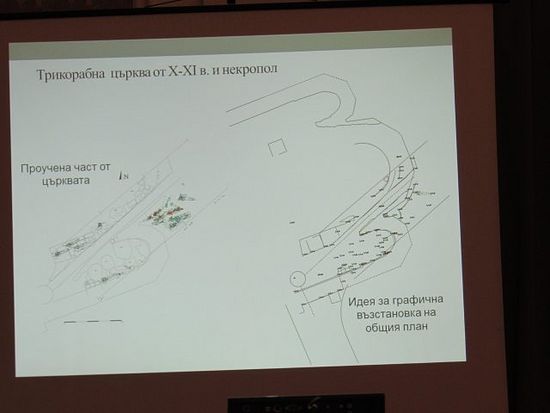 A sketch of the unearthed foundations of the 10th-11th century church and the necropolis. Photo: Ruse Info
A sketch of the unearthed foundations of the 10th-11th century church and the necropolis. Photo: Ruse Info
The newly discovered temple is a three-nave church; it is located next to an identical church which had been found earlier; the two temples functioned during almost the same time period.
Medieval Drastar was dotted with palaces and churches, many of them from the period of the First Bulgarian Empire(632/680-1018); the 2015 rescue excavations also led to the discoveries of what was likely the oldest Bulgarian medieval church in the city, dating back to the 9th century, and a second cathedral of the Bulgarian Patriarchate from the 10th century.
In addition to the church ruins, the Ruse archaeologists have also discovered a necropolis around the temple, and excavated a total of 37 graves. The funeral inventories they revealed consist of adornments or clothing elements as well as several coins in a bad condition.
Several other graves dating back to the 14th century and the Late Ottoman period (17th-19th century) have also been found.
In archaeological structures dating back to the High and Late Middle Ages in their section of the Archaeological and Architectural Preserve “Durostorum – Drastar" (Silistra), the archaeologists have discovered coins which are said to testify to the Tatar (Mongol) invasion of the Second Bulgarian Empire (1185-1396 AD) in 1242 AD.
The newly discovered coins consist of two collective coin finds, and seven individual coins.
One of the collective finds is better preserved, and made up of a total of 56 copper coins of Byzantine Emperors Manuel I Comnenus (Komnenos) (r. 1143-1180), Isaac II Angelus (Angelos) (r. 1185-1195), and Alexius III Angelus (Alexios III Angelos).
The rest are Byzantine and Bulgarian coins from the 13th-14th century, which are said to “date very well the Tatar (Mongol) invasion of 1242 AD".
The latest of the coins belonged to some of the last Tsars of the Second Bulgarian Empire, Ivan Alexander (r. 1331-1371) and Ivan Shishman (r. 1371-1395).
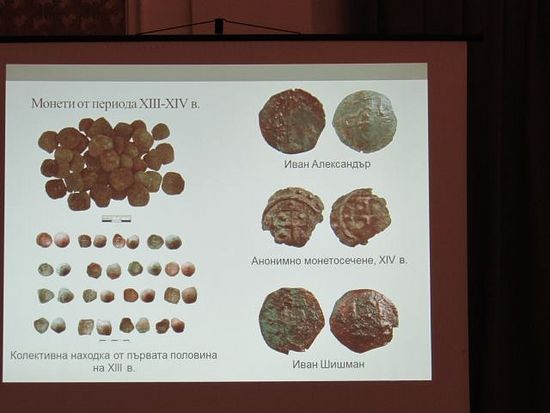 The coin finds finds: left top – coins from the 13th-14th century; left bottom – a collective coin find from the first half of the 13th century; right top – coins of Tsar Ivan Alexander (1331-1371); right middle – anonymous coins from the 14th century; right bottom – coins of Tsar Ivan Shishman (1371-1395). Photo: Ruse Info
The coin finds finds: left top – coins from the 13th-14th century; left bottom – a collective coin find from the first half of the 13th century; right top – coins of Tsar Ivan Alexander (1331-1371); right middle – anonymous coins from the 14th century; right bottom – coins of Tsar Ivan Shishman (1371-1395). Photo: Ruse Info
Other discoveries from the same section of the rescue digs in Silistra include the ruins of a Late Ottoman building and fragments from ceramic vessels from the 17th-19th century.
Unfortunately, the Ruse archaeologists will be unable to expand on their findings in the said section in Silistra because after the completion of the water supply rehabilitation project, the exposed archaeological structures have been reburied.
This has understandingly sparked outrage on part of local development activists who have criticized both the local and the central government for its failure to preserve Silistra’s unique historical, cultural, and archaeological heritage, and to use it to boost tourism.
Background Infonotes:
The Ancient Thracian and Roman city of Durostorum (Dorostorum) – known as Dorostol or Drastar (Drustur) during the periods of the Bulgarian Empire in the Middle Ages – is the precursor of today’s Bulgarian city of Silistra. It was originally founded as an Ancient Thracian settlement on the Lower Danube. In 29 AD, the Romans built there a fortress keeping the settlement’s Thracian name of Durostorum (or Dorostorum). After his victories wars over the Dacians north of the Danube, Roman Emperor Trajan stationed the elite Claudius’ 11th Legion – Legio XI Claudia – at Durostorum, and the fortress remained its permanent seat until the demise of the Roman Empire. In 169 AD, during the reign of Emperor Marcus Aurelius (r. 161-180 AD), Durostorum was made a Roman city – a municipium. Between the 2nd and the 4th century AD, it was a major urban and military center of the Roman Province of Moesia Inferior (later divided into Moesia Secunda and Scythia Minor), and a major Roman stronghold against the barbarian invasions. The earliest 12 Christian saints from the territory of today’s Bulgaria are Roman soldiers executed in Durostorum during the Great Persecution of Emperor Diocletian between 303 and 313 AD, including St. Dasius and St. Julius the Veteran. In 388 AD, today’s Silistra became the seat of a Christian bishopric. Roman general Flavius Aetius (391-454 AD), who is known as “the last of the Romans" for his army’s victory over the Huns in the Battle of the Catalaunian Plains in 451 AD, was born in Durostorum. During the barbarian invasions of Sarmatians, Goths, Huns, Avars, Slavs, and Bulgars the city was ransacked several times. It was rebuilt during the reign of Byzantine Emperor Justinian I the Great (r. 527-565 AD).
The Slavs settled in Durostorum around 590 AD, and named it Drastar (Drustur). The city became part of the First Bulgarian Empire (632/680 – 1018 AD) around 680 AD. Bulgarian Khan (or Kanas) Omurtag (r. 814-831 AD) is known to have built there a large imperial palace known as the Danube Palace of Bulgarian Khans where later Bulgarian Tsar Simeon I the Great (r. 893-927 AD) resided in 896-897 AD. In 895 AD (during the Bulgarian-Hungarian War of 894-896 AD), the Magyars (Hungarians), allies of Byzantium, besieged the Bulgarian army under the personal command of Tsar Simeon I the Great in the fortress of Drastar but were repulsed. The next year the Magyars were decisively defeated by the Bulgarians in the extremely fierce Battle of Southern Buh (in today’s Ukraine) which eventually led their tribes to retreat to the west and settle in the region of Pannonia essentially founding today’s Hungary.
During the later years of the First Bulgarian Empire the region around today’s Silistra was known for its rock monasteries. In 927 AD, Drastar became the seat of the first internationally recognized Patriarch of the Bulgarian Orthodox Church, Patriarch Damyan. In 969 AD, it was captured by Knyaz Sviatoslav I of Kiev, the ruler of Kievan Rus in 945-972 AD, but two years later it was conquered by Byzantium under Emperor John I Tzimiskes (r. 969-976 AD) in the Battle of Dorostolon, and renamed Theodoropolis, after military saint Theodore Stratelates. In 976 AD, Bulgaria’s Tsar Samuil (Samuel) (r. 977/997-1014 AD) regained the city until 1001 AD when it was again conquered by the Byzantine Empire.
Drastar was a metropolitan’s residence and a major fortress during the Second Bulgarian Empire (1185-1396 AD). In 1279 AD, under Tsar Ivailo (r. 1277-1280), Drastar withstood a three-month siege by the Mongols. It was conquered by the invading Ottoman Turks in 1388 AD (ca. 1400 AD, according to some sources), and turned into a major Ottoman fortress. Subsequently, Silistra has remained a major urban center in the Lower Danube region.

